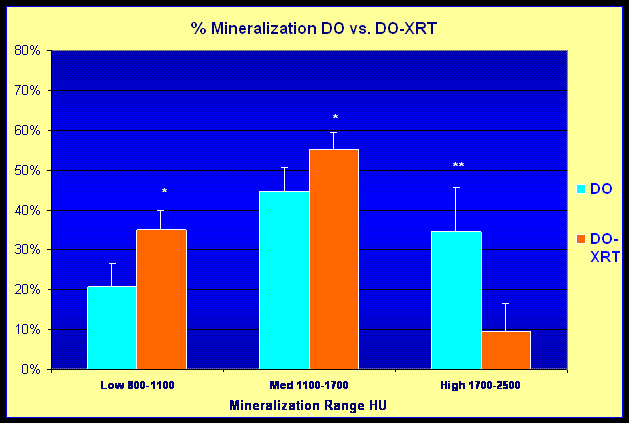Tuesday, October 10, 2006
11257
Radiation Attenuated Mandibular Distraction Osteogenesis Healing is Quantified by the Percent and Degree of Bone Regenerate Quality Using Micro-CT (ÁCT) Algorithms
Introduction: Determining the degree by which therapeutic radiation (XRT) attenuates bone healing is integral before attempting to consider the use of mandibular distraction osteogenesis (DO) in head and neck cancer reconstruction. While prior animal studies have shown results which vary from non-union to purported success with lower therapeutic doses, no documented metrics have outlined the extent of either XRT attenuated bone healing or the impact of radiation on the quality of DO regenerate. Our goal was to utilize non-destructive imaging measures to characterize the precise deficits within DO after XRT in the lower therapeutic ranges. We hypothesized that XRT will decrease the amount of bone density and impede the maturation of normal bone healing. Methods: Male Sprague-Dawley (~325g) rats underwent 36Gy pre-operative external beam irradiation (X-Ray), fractionated at 3.75Gy/day x 10 days to the left hemi-mandible followed by 2 weeks recovery before surgery. A titanium frame distractor was secured bilaterally to the mandible and a left vertical osteotomy placed posterior to the 3rd molar. Our established DO protocol was performed: 4d latency, 0.3mm q12hr distraction x 8.5 days to 5.1mm total distraction. After 28 days of consolidation, euthanasia preceded dissection of the left hemi-mandible. Our un-operated controls (uC-XRT) followed the same XRT and 2 wk recovery protocol. ÁCT: Mandibles were scanned at 45um voxel resolution then reconstructed. Established region of interest templates were placed by independent reviewers, using anatomical and surgical landmarks, centered to encompass the gap and matched for the uC-XRT group. Bone mineral content (BMC), bone mineral density (BMD) and bone volume fraction (BVF), along with micro-densitometric mineralization assessment, in Hounsfield units, was calculated. Groups: DO, n=24; DO-XRT, n=6; uC, n=18; uC-XRT, n=8. Data for variables was recorded as mean +/- SD. Data from DO and uC, not exposed to XRT, was utilized from the preceding study. Analysis using ANOVA followed by appropriate post-hoc comparisons was performed. A p-value of < 0.05 was considered significant. Results: BMD was lower in the DO-XRT group compared to the DO regenerate group (p=0.06). No significant differences were found when comparing BMD or BVF in the uC vs. uC-XRT. However, there was a significantly greater amount of low and medium mineralized regenerate bone in the DO-XRT samples compared with standard DO regenerate. Similarly, the percentage of highly mineralized bone was significantly lower in the DO-XRT specimens vs. DO alone. Conclusions: This study utilized non-destructive ÁCT imaging techniques and algorithms to delineate which particular facets of bone healing are diminished in DO after XRT. We found a significant decrease in the percentage of highly mineralized or mature bone and a significantly higher percent of immature bone in the DO-XRT group when compared to the DO regenerate in the non-irradiated group. We also found a substantial trend toward lower overall BMD in DO-XRT, approaching statistical significance. The data generated in this study quantified and outlined the extent of XRT attenuated healing and the reduced quality of regenerate in mandibular DO after irradiation utilizing established metrics that we have developed in our lab. Our findings should help direct therapeutic intervention aimed at mitigating the specific detrimental effects of XRT on DO thereby facilitating the use of the technique as a predictable and durable means of post-oncologic head and neck reconstruction.

View Synopsis (.doc format, 76.0 kb)
See more of Cranio/Maxillofacial/Head & Neck
Back to 2006am Complete Scientific Program
